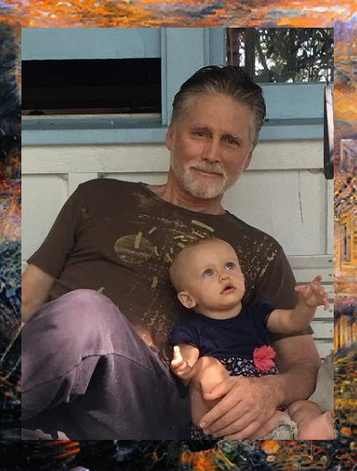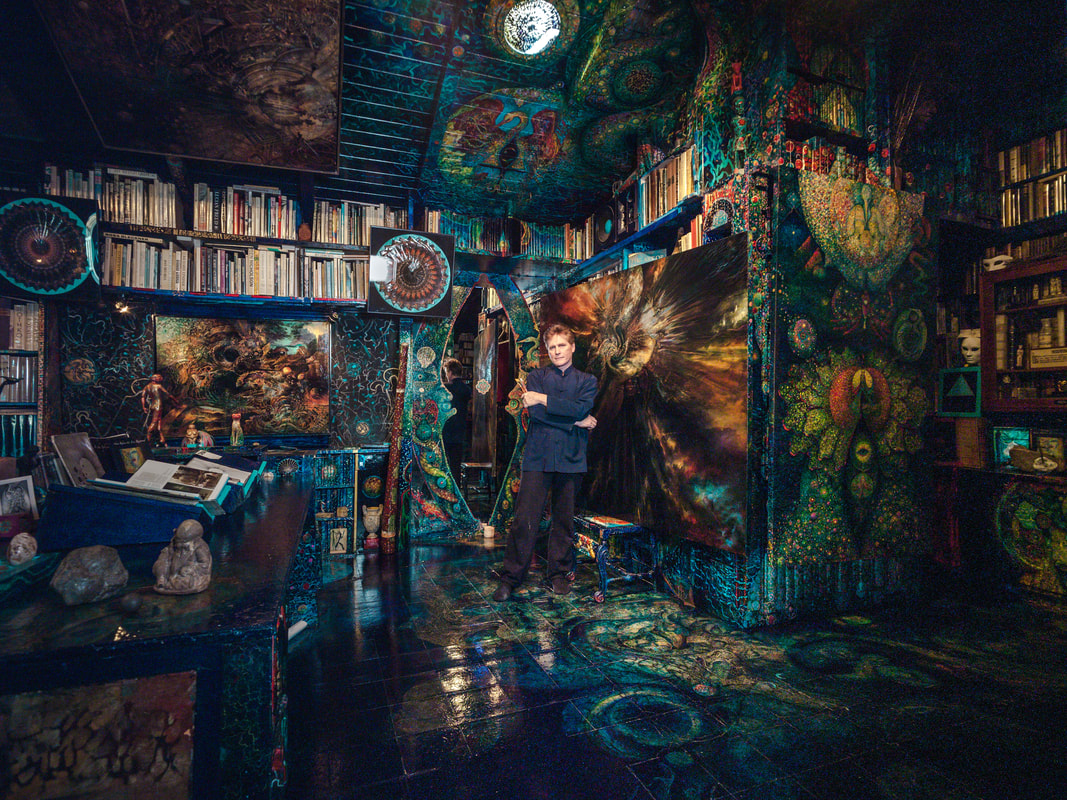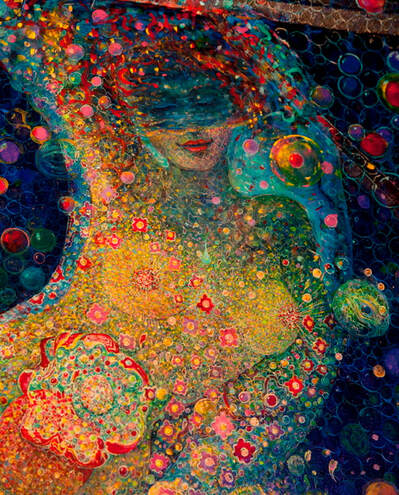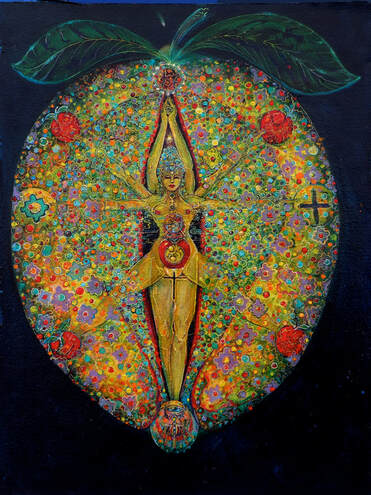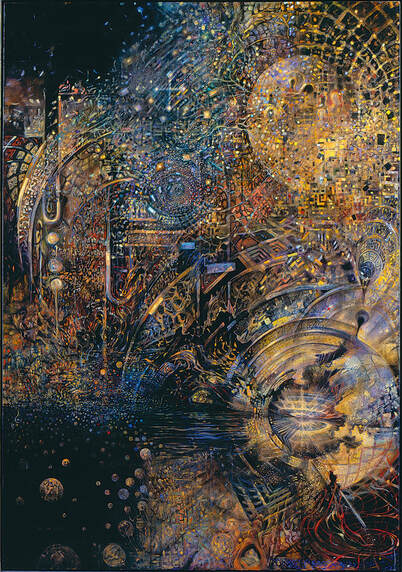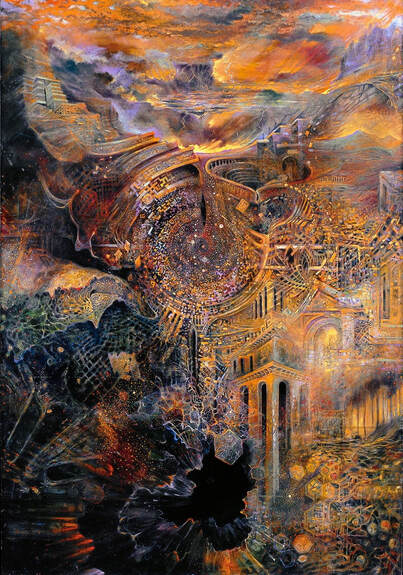JUNE 2020: Featured Artist
Artist, Actor & Visual Philosopher
Leigh McCloskey
~~~
|
Leigh with Granddaughter, Leighton
|
Leigh J. McCloskey is a modern renaissance man. He is an artist, actor and visual Hermetic philosopher. His life, career and art reveal in beauty and meaning his devotion to the ideal of cultivation renaissance and imaginative rebirth through shared enthusiasm for the more interesting and inspiring stories of being human.
Leigh has enjoyed a long career in Hollywood as a professional actor, starring in numerous TV and film productions. In 2005, Keith Richards selected Leigh’s art to tour with the Rolling Stones for their “A Bigger Bang Tour.” More recently, art from his illuminated books, titled The CODEX TOR, formed the visuals for Flying Lotus’ highly acclaimed album Cosmogramma. He has written, illustrated and published seven books as well as many articles. Leigh’s Hermetic masterwork of art and writing, “Tarot ReVisioned” was reviewed as quite possibly the most significant contribution to the tradition in over 100 years. He lectures both nationally and internationally and has been a regular presenter with the New York Open Center’s Esoteric Quest services. (Readers can find many of his talks posted on his YouTube channel.) Leigh was born and raised in Malibu. He and his wife, Carla (an author and director), returned to Malibu in 1982 where they continue to reside. They have hosted weekly discussion groups and public/private events at their home since that time. |
Leigh named their home Olandar from stories he had told his daughters when they were little girls. He created the “ideal philosophical seed” of Olandar Foundation for Emerging Renaissance (OFFER) and Olandar Press Ltd. Within their upstairs library studio, Leigh has painted and continues to paint his remarkable 3D masterwork, “The Hieroglyph of the Human Soul” (creating the unplanned acronym: THOTHS Library). He began painting the library with the emergence of the “Watcher Language” on 9-11-01, an original and remarkable work within domestic space that covers the walls, floor, ceiling and furniture creating a vast cave painting.
Myrna Beth Haskell, managing editor, spoke with Leigh via Zoom about his artistic journey and his ongoing project The Hieroglyph of the Human Soul. Myrna appreciated a virtual tour of the upper-level library at Olandar – a mind-boggling space where a 3D kaleidoscope of colorfully painted stories ebb and flow, one to another, in an intimate dance.
You majored in drama at Juilliard. Did you also take classes in fine art?
I was always drawing. When you can’t talk about something, you draw it.
My dad, artist Joseph G. McCloskey, was a painter and original founder of the Malibu Art Association. He felt he was over-trained and would think too much into what he was doing. So he told me not to study art formally. Instead, he told me to study the painters I was attracted to – this is how I began to train my eye.
I started to use my painting to express myself emotionally. As an actor, you find the physicality needed [for a role]. Similarly, I would use my whole body to paint – my elbows, the backs of my hands, my fingers. As a painter, you’re building a relationship with the paper.
If you think about art, you begin to ask questions: Why was it done? Where was it done? Who did it, and for what purpose? When I became fascinated with art, minimalism was being taught, which was antithetical to my nature because I’m a philosopher with paint. I’m interested in understanding the nature of the soul and the psyche. For me, painting is the language of the creative spirit. The questions I needed to ask weren’t being asked, or they were being asked and ridiculed.
For years, you had a successful career as a full-time actor, and now you are immersed in the visual arts. Are there any connections?
When you’re an actor, you are entering into another’s psychology. This trained me to look at the world from different perspectives.
You majored in drama at Juilliard. Did you also take classes in fine art?
I was always drawing. When you can’t talk about something, you draw it.
My dad, artist Joseph G. McCloskey, was a painter and original founder of the Malibu Art Association. He felt he was over-trained and would think too much into what he was doing. So he told me not to study art formally. Instead, he told me to study the painters I was attracted to – this is how I began to train my eye.
I started to use my painting to express myself emotionally. As an actor, you find the physicality needed [for a role]. Similarly, I would use my whole body to paint – my elbows, the backs of my hands, my fingers. As a painter, you’re building a relationship with the paper.
If you think about art, you begin to ask questions: Why was it done? Where was it done? Who did it, and for what purpose? When I became fascinated with art, minimalism was being taught, which was antithetical to my nature because I’m a philosopher with paint. I’m interested in understanding the nature of the soul and the psyche. For me, painting is the language of the creative spirit. The questions I needed to ask weren’t being asked, or they were being asked and ridiculed.
For years, you had a successful career as a full-time actor, and now you are immersed in the visual arts. Are there any connections?
When you’re an actor, you are entering into another’s psychology. This trained me to look at the world from different perspectives.
|
Please walk me through how your work is displayed throughout Olandar.
My home is ranch style and very domestic. There are three levels. Simply: The bottom level is the structure [Leigh’s Tarot ReVisioned series in black and white is displayed here] - the black and white keys which represent the different qualities, functions and informing principles that create both the individual and collective psyche; Above is imagination, the library [Leigh’s ongoing work, The Hieroglyph of the Human Soul, is displayed here], where the books of all the different histories and human stories live and breathe; the in-between level represents domestic responsibility (physically where the living room, kitchen, and bedrooms are – our family living space). The job of the creative spirit is to ask the questions. So you – the visitor – come in through below, but you also leave through below. Ask yourself this: Why does Dorothy leave Kansas? She leaves because she wants to know there’s more behind the difficulty and struggles, and that there is greater character behind the face of things. But this doesn’t mean she wants to ‘get out of anything.' She doesn’t want to leave those she loves, so she goes back to the black and white world that is Kansas. |
|
“Olandar is created as a philosophical ark that calls out to those who still care to begin telling the story of what makes being human meaningful and to live it even if the world thinks them mad.” (The Emerging Renaissance, Leigh McCloskey)
|
|
Is your work that represents the Major Arcana of the Tarot* strictly on the lower level? It took me 17 years to complete the Tarot ReVisioned series (in black and white) which lines the studio at the lower level. I designed this space for my father. This is where he was going to live when he turned 90, but he died at his home before he could move in with us. Tarot comes out of Hermetic traditions** from ancient times. The Emerald Tablet of Hermes represents ‘As above, so below’ - whatever happens above happens below. This lower level encourages the basic question ‘Who am I?’ Ultimately, you are all of the qualities and influences represented, but you don’t have to specifically identify with any of them. For instance, what you think is the enemy…well, if you make this the enemy, you invite this into your story. |
*Major Arcana of the Tarot: Generally speaking, the cards represent the life lessons, karmic influences and archetypal themes that are influencing your life and your soul's journey to enlightenment. These Tarot cards represent the structure of human consciousness and hold the keys to life lessons passed down through the ages.
**Hermeticism is a religious, philosophical and esoteric tradition based primarily upon writings attributed to Hermes Trismegistus. These writings greatly influenced the Western esoteric tradition (combining spirituality with an empirical observation of the natural world) and were considered to be of great importance during both the Renaissance and the Reformation.
**Hermeticism is a religious, philosophical and esoteric tradition based primarily upon writings attributed to Hermes Trismegistus. These writings greatly influenced the Western esoteric tradition (combining spirituality with an empirical observation of the natural world) and were considered to be of great importance during both the Renaissance and the Reformation.
“The Tarot is a tool not a belief. Its genesis was and is an ongoing creative question. Its real value is that it helps an individual to examine life’s myriad questions in new ways. “Tarot ReVisioned” is an invitation to journey inward and, in so doing, to awaken the inner splendor of being human.” ~ Leigh McCloskey
|
I read that the events of 9/11 were a catalyst to the idea behind The Hieroglyph of the Human Soul which is your ongoing work in the library (the top level). Was this a pivotal point in your artistic journey? Did your intent and focus change?
Yes. You start to ask questions: What do you do with evil? How do you pull out of the anguish? Well, instead of fighting this, you can love in spite of the dark. Look to the faces of the children, look at the families, look at life. When the towers* came down – symbols of money and power - we were left on our knees, both psychologically and emotionally. But our strength is in what we value, not what the world values. The question isn’t what’s wrong with your neighbor, it’s how you live with yourself and how you live with what’s inside of you. I was an oil painter at first. I didn’t care for acrylics, but I began using them out of necessity. I started with the library floor, but I couldn’t paint the floor in oil, so I used acrylics. It actually took three years to complete the floor, and the irony of it is that I painted on my knees. I didn’t want to change the linoleum; it’s still linoleum. Instead, it became a ground to cultivate. I then started painting all of the surfaces, the upholstery on the furniture, the book spines. |
Leigh Standing in the THOTHS Library at Olandar
Photo Credit: Dana Tynan |
What is dark and masculine in the lower level is bright and vibrant above. It restores and nourishes. The Tarot project was such hard, grueling work. I was clawing through it. I didn’t realize it at the time, but I was creating canals. After 9/11, my work just started to flow from me - the images emerged. For a painting of a beautiful woman…well…I don’t know what that looks like, but I know what that feels like. I’m just following my hand, and she sensually emerges to the point where she feels right.
*The Twin Towers in downtown New York City collapsed after two hijacked planes crashed into them on the morning of September 11, 2001 (9/11).
*The Twin Towers in downtown New York City collapsed after two hijacked planes crashed into them on the morning of September 11, 2001 (9/11).
"The eight paintings in the series Universe as Organism, which are now energetically woven into the larger archetypal entity of The Hieroglyph of the Human Soul, grew out of the creative exploration of the idea that consciousness, when it abstracts itself from the body and sensual knowing, forgets the profound truth that many of the most important questions about life can only be lived and not answered in words, systems, or beliefs. The series explores multidimensional ideation and consciousness as an organic whole, a great body forming the Mysterium Magnum. The Universe as Organism series are doorways into archetypal imagination and the multidimensional corpus of being." (LeighMcCloskey.com)
Please explain The Hieroglyph of the Human Soul a bit more.
The library begins to reveal a story…that as we’ve asked the question - over and over again - What does it mean to be human…we’ve weaved through the ages, through the histories of human struggle, human civilization, human religions. And a story developed that has risen to its own context. To know who we are, we must stand in the library and realize that for us to be here, we had to live through all of these questions so we could finally be home to ask our own question: How do I live in the outcome of all of this?
The library begins to reveal a story…that as we’ve asked the question - over and over again - What does it mean to be human…we’ve weaved through the ages, through the histories of human struggle, human civilization, human religions. And a story developed that has risen to its own context. To know who we are, we must stand in the library and realize that for us to be here, we had to live through all of these questions so we could finally be home to ask our own question: How do I live in the outcome of all of this?
|
The Hieroglyph of the Human Soul is a transformative journey that flows and becomes a pattern of consciousness to set our collective creativity in motion. It’s a picture book of the human soul. It contains the stories of who we are and why we are here.
Purpose of the Project: “To found and establish a convincing mythic, archetypal, collective and domestic theatre of the mind that synthesizes and nourishes the diversity and modes of inquiry that form the heart of human curiosity and our desire to know the depth of things.” (Leigh McCloskey, The Hieroglyph of the Human Soul) And the level in-between Tarot ReVisioned and the THOTHS Library? This is the space that divides above and below. It’s our domestic living space – where we learn to live with each other. |
|
It sounds like you have always created for self-discovery. But your generous spirit invites others in. Could you explain further?
Don’t ask people what they think of your art; instead, ask them what your art makes them think. You can’t change the world, but you can grow your own garden. If someone says it doesn’t matter to them, say it matters to me.
Creative people have to get together and inspire one another. I create my art for me, but I invite everyone in. I’ve had musicians here…people come from all over the world….from all backgrounds.
Leigh and his wife, Carla, open their home to creatives, healers and others - a gathering place for discussion groups, book readings and eclectic events.
Don’t ask people what they think of your art; instead, ask them what your art makes them think. You can’t change the world, but you can grow your own garden. If someone says it doesn’t matter to them, say it matters to me.
Creative people have to get together and inspire one another. I create my art for me, but I invite everyone in. I’ve had musicians here…people come from all over the world….from all backgrounds.
Leigh and his wife, Carla, open their home to creatives, healers and others - a gathering place for discussion groups, book readings and eclectic events.
|
Performance by The Rolling Stones during their "A Bigger Bang Tour" with Leigh's Grimoire
Photo Courtesy: Leigh J. McCloskey |
I have to ask because I’m a huge fan of The Rolling Stones. Your artwork was used on stage during their “A Bigger Bang Tour" (2005-2007). How did that come about?
Laughing. Well, I guess you could say that this was my first public outing. I was asked to create a grimoire* for a film [Shadow of the Vampire, with John Malkovitch and Willam Defoe, directed by E. Elias Merhige]. It never made it to the final cut, but it got the attention of Keith Richards and was used during their tour.** It’s an unbelievable feeling to know that the work was so large and on stage as part of the performances. *A book of instructions in the use of alchemy or magic, especially one containing spells for summoning demons. **Images from Leigh’s Grimoire were projected onto an enormous screen towards the back of the stage. Its pages framed Keith Richards as he performed his acoustic solo, “In a Lonesome Place.” It was the only artwork in the show, the rest being computer-generated designs. (leighmccloskey.com) |
|
“To sit in the Hieroglyph is to sit in art. One is within its embrace, inseparably bound to it by gravity.” ~ Leigh J. McCloskey |

